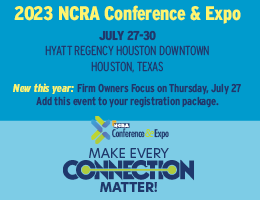 Brian DiGiovanna, RPR, began his career as a freelance reporter in 1979. In the early 1980s, he joined the New York Supreme Court as an official court reporter and still holds that position. DiGiovanna also holds the position of president for the Association of Supreme Court Reporters in New York City. He has been president for the past eight years and, in his role, represents 340 Supreme Court court reporters. In addition, DiGiovanna regularly travels to Albany to meet with legislators to discuss issues that affect court reporters. DiGiovanna sits down with the JCR to tell us more about his role as president and what it takes to be successful in the courtroom.
Brian DiGiovanna, RPR, began his career as a freelance reporter in 1979. In the early 1980s, he joined the New York Supreme Court as an official court reporter and still holds that position. DiGiovanna also holds the position of president for the Association of Supreme Court Reporters in New York City. He has been president for the past eight years and, in his role, represents 340 Supreme Court court reporters. In addition, DiGiovanna regularly travels to Albany to meet with legislators to discuss issues that affect court reporters. DiGiovanna sits down with the JCR to tell us more about his role as president and what it takes to be successful in the courtroom.
As president, what are your main responsibilities?
My main responsibility is to represent my members. Their jobs and their livelihoods are my main concerns. If problems arise involving the court reporter, I try to resolve them. I negotiate contracts, represent people who get into trouble, and file complaints on the union’s behalf if administration breaks agreements. I also deal with benefits for members, negotiating new agreements and modifying old ones.
I am politically active. I go to Albany, New York’s capital, every two to three weeks during the session, attending political events such as fundraisers and meeting with various legislators to discuss different issues that affect court reporters. One of the issues I am dealing with right now is limiting the use of electronic recording in lower court, keeping it out of Supreme Court, and working on an agreement with Chief Administrative Judge, Judge Prudenti. If we broker this deal, it will limit the use of ER in lower court and keep ER out of Supreme Court. One of the important aspects of going to Albany is to develop relationships with the politicians. You cannot do this in one meeting; it takes time to develop.
What have been the challenges of your role?
In the beginning of my career as a union president, it was learning how to deal with all of the various issues that come your way. It takes about two years to become comfortable in this role.
What you learn quickly is you cannot know everything. When you learn that it is okay not to know everything, and you recognize the importance of reaching out for help and bringing in the people who can perform a certain role to get a job done, I believe you have reached the right aspect of the job. Giving credit where credit is due is very important. I do not care about getting the credit; I care about getting a job done.
What have been the rewards?
The reward is knowing that we work together, my officers and my executive board, to achieve our common goal: Keeping court reporters relevant in an ever-changing environment.
What does it mean to be successful in the courtroom?
Success in the courtroom has changed dramatically from when I first started in the late 1970s. One thing that remains the same is producing a good record, which, at the end of the day, is what people want.
The dramatic change is realtime and CART. When I first began to offer realtime, very few people were interested in providing it. Today, we are working on a program offering realtime to one judge in every courthouse in every borough with the city of New York for an 18-month period. We have three courthouses up and running, and we expect to have two more on board by the end of the summer. Realtime is what needs to be done to ensure we have jobs in three, five, and 10 years. Change will always take place, and it is us, the court reporters, who can accept the ever-changing workplace and make the changes work for us.
Electronic recording, without trained operators, does a poor job in recording the testimony. Too many errors are produced as a result of no operators. But when operators are added to the cost equating, the costs increase and may make it less attractive to replace the stenographic court reporter.
Can you talk about how you went about setting up and running a very technologically advanced courtroom?
Creating the courtroom of the future in New York provided me with a way of speaking to the Bar and judges about why court reporters are an important part of the equation. Providing realtime enables the attorneys and the judges to see what was said without stopping the proceedings, which, at times, could be an issue for attorneys. Judges sometimes will not stop the proceedings to have something read back. But with realtime, it is right in front of them.
The set-up for the high-tech courtroom is as simple as a projector and digital document camera, such as the Wolfvision units. The more sophisticated units have monitors at counsel table and in front of the jury, and the ability to plug your computer into the system to show evidence. The witness and the judge have monitors. The witness and counsel could have a touch screen with the ability to circle sections of information for visual display with different colors to differentiate between the speakers.
On cases where money can be spent on hiring companies to provide a digital presentation, companies such as Doar, Trial Graphics, and others, they will come in and work with you to create a presentation of your evidence from their computers, using colors, displays, larger fonts, and pull outs, which have been placed into software, allowing the displayer the ability to focus on specific information of a document, compare side-by-side documents, and so on.
How important are credentials and continued education in becoming successful?
Credentials are an essential part of our business. Credentials show that someone has achieved a minimum expertise. With each credential you get, you will want to achieve a higher standard and a greater expertise. Continued education allows you to learn new technologies and new ideas. It allows someone to talk about an idea that may go nowhere or grow to something that person never thought would have gone anywhere. It’s very important to keep abreast of the field you work in.
What would be the best advice you could give a student who is about to enter the field?
Practice, practice, and practice more. It is a great job for those who have what it takes to get through school, make it through the couple of years it takes to get experience, and begin to get a good sense of what it takes to be a court reporter. It is not only making a record. It is also about learning technology, learning the software you use, and how to incorporate viewers of what you are writing, whether it is CART, captioning, or realtime.
What are the most important things a court reporter should know about working with the courts and court administrative staff when it comes to everyday dealings, as well as promoting the court reporting profession?
Working with the courts is a little different than freelancing. You have administrators who do not care about court reporters; they care about running the system. You have bosses, if you are lucky, who are or were court reporters.
With that said, if you are in a location where all of your bosses have no idea what the job entails, it could make for a difficult job. It is unfortunate that many people think the job is easy, just sitting there and writing all day long, with few or no breaks, when, in fact, writing all day puts stress on your arms, neck, back, and hands. People need to understand that breaks are important to court reporters, just as they are to the court officers, court clerk, bailiff, and even the judge.
Where do you see the court reporting profession going in the future? And what do reporters need to do to prepare for that?
As long as we, the court reporting profession, continue to push to learn, whether it is CART, captioning, or realtime, we will have a profession. Administrators will look at the bottom line. It is up to us to show them that we add expertise and value to the bottom line. Providing realtime to a judge will make the judge want a court reporter and fight for a court reporter. If something new is not provided to judges, they may think ER is something new and better. And even though it may not be, not providing new technology – realtime – may be all that is necessary for a court to say, “Let’s try ER.” Take realtime courses, become realtime certified, and promote the profession.




